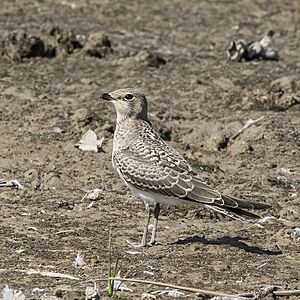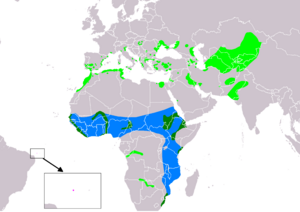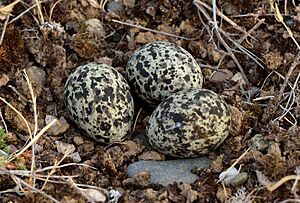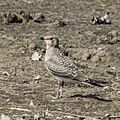Collared pratincole facts for kids
The collared pratincole (Glareola pratincola), also called the common pratincole or red-winged pratincole, is a type of wader bird. It belongs to the pratincole family, Glareolidae. Like other pratincoles, it lives in the Old World (Europe, Asia, and Africa).
Quick facts for kids Collared pratincole |
|
|---|---|
 |
|
| Adult | |
 |
|
| Juvenile | |
| Conservation status | |
| Scientific classification | |
| Genus: |
Glareola
|
| Species: |
pratincola
|
 |
|
| Range of G. pratincola Breeding Resident Non-breeding Vagrant (seasonality uncertain) | |
| Synonyms | |
|
Hirundo pratincola Linnaeus, 1766 |
|
Contents
About the Collared Pratincole's Name
Scientists give every animal a special two-part name. This helps everyone around the world know exactly which animal they are talking about.
The collared pratincole got its first scientific name from a Swedish scientist named Carl Linnaeus in 1766. He first thought it was like a swallow. Later, it was placed in the group (genus) called Glareola.
The name Glareola comes from a Latin word meaning "gravel." This is because these birds often nest in gravelly places. The second part of its name, pratincola, means "meadow inhabitant" in Latin. So, its name tells us a bit about where it likes to live!
There are two main types (subspecies) of collared pratincoles:
- Glareola pratincola pratincola: Found from southern Europe and North Africa to southern Pakistan.
- Glareola pratincola fuelleborni: Lives in Africa, south of the Sahara Desert, all the way to eastern South Africa.
What Does a Collared Pratincole Look Like?
The collared pratincole is a medium-sized bird. It is about 24 to 28 centimeters (9.4 to 11 inches) long. Its wings can spread out about 60 to 70 centimeters (23.6 to 27.5 inches) wide.
This bird has short legs and long, pointed wings. It also has a long, forked tail, which looks a bit like a swallow's tail. Its beak is short, which is perfect for catching insects while flying.
Its back and head are brown. The wings are also brown, with darker feathers used for flying. Its belly is white. If you look under its wings, you'll see a chestnut (reddish-brown) color. This color looks dark when the bird is flying.
It can be tricky to tell this bird apart from other pratincoles. For example, the black-winged pratincole and oriental pratincole look very similar. The oriental pratincole also has chestnut underwings but has a shorter tail.
Where Do Collared Pratincoles Live?
Collared pratincoles love open spaces. You can often see them near water, especially in the evening. They fly around catching insects there.
These birds live in the warmer parts of Europe, southwest Asia, and Africa. They are migratory birds. This means they travel long distances. They spend their winters in tropical Africa. It's rare to see them far north of where they usually breed.
How Do Collared Pratincoles Behave?
Eating Habits
Pratincoles are special among wader birds. Most waders look for food on the ground. But pratincoles usually hunt for insects while flying, just like swallows do! They can also find food on the ground sometimes.
Raising Young
Collared pratincoles nest in groups. They make a simple nest, which is just a shallow scrape on open ground. They often choose spots near water.
A female bird usually lays 2 to 4 eggs. The eggs are cream-colored with black or dark brown spots and streaks. Each egg is about 32 by 24 millimeters (1.26 by 0.94 inches) and weighs about 10 grams (0.35 ounces).
Both parents take turns sitting on the eggs to keep them warm. This is called incubation. The eggs hatch at about the same time, after 17 to 19 days.
The young chicks are quite developed when they hatch. They can leave the nest after only 2 or 3 days! Both parents take care of them. For the first week, the parents feed the chicks food they have already eaten and brought back up. The young birds learn to fly when they are about 25 to 30 days old.
Protecting Collared Pratincoles
The collared pratincole is part of an important agreement. This agreement is called the Agreement on the Conservation of African-Eurasian Migratory Waterbirds (AEWA). It helps protect birds that travel between Africa and Eurasia.
Images for kids







